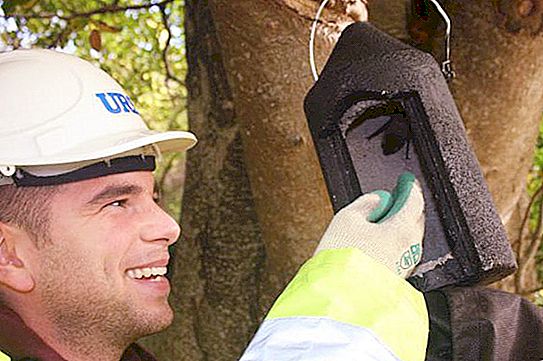Video: Workday Tutorial - 02 Employee, Job profile 2024, May
Before each manager or HR manager, sooner or later, the question of filling a vacant position becomes. Choosing a good specialist is not an easy task. For this purpose, managers quite often draw up job profiles that help you navigate the requirements for the applicant.
Definition of a concept
Job profiles are a set of professional and personal competencies that a candidate for a job must meet. At the moment, there is no formalized description of the characteristics that a representative of a particular profession should possess, and therefore managers draw up these documents independently.
We can say that the profile of the position is a kind of standard according to which the employee must fulfill his duties. The description should be detailed, and most importantly - realistic. The document should display the following main items:
- the place and significance of the position in the organizational structure of a particular enterprise;
- functional responsibilities that must be performed by the employee accepted for this position;
- a profile that lists the core competencies that a candidate for a position should possess;
- personal qualities that are necessary for the performance of certain duties;
- minimum list of requirements that the organization puts forward to its employees.
Thus, we can say that job profiles are a set of characteristics that an employee must meet. This is a specific standard that describes the responsibilities, as well as the qualification and personal parameters of the applicant.

Why do I need job profiles
HR managers regularly face the issue of closing a vacant position. Not having drawn up an exhaustive profile of the position, you should not proceed with the direct selection of employees. This document is a hint that is used in the following cases:
- selection of candidates for filling vacant posts;
- for certification of already working personnel in order to reveal the degree of compliance with the position held (this also applies to employees who have passed the probationary period);
- in order to draw up plans for staff training and advanced training;
- if you need to create a reserve of personnel for the future;
- in order to plan career growth and further promotion of employees to senior positions in the organization.
Quite often, the job profile of a candidate for a post is confused with job description. The fundamental difference between the two documents is that the second is compiled on the basis of legal requirements. Job description is a general document that is prepared for the profession as a whole, and not for a specific employee of a particular organization. It defines the main responsibilities and working conditions. A job profile is a document of a local nature that does not have clear requirements for content and structure. The personnel manager (or other personnel employees) compiles it based on their own experience or the general practice of the organization.

Professional competencies
Each position requires an employee to possess certain competencies. These are qualification characteristics that are necessary for the performance of certain works. So, the competency profile of a post usually includes the following items:
- strategic thinking (implies the ability to make long-term plans taking into account possible risks and alternative options);
- influence on others (the ability to defend one’s point of view, as well as to convince others of its correctness);
- problem-solving skills (ability to adequately respond to non-standard situations and difficulties, as well as quickly find ways out of them);
- information search (data selection and filtering, the ability to find and use relevant sources);
- ability to work with clients and counterparties (taking into account interests, understanding psychology, satisfying wishes and needs);
- flexibility (rapid response and decision-making in accordance with a changing situation);
- focus on quality (knowledge and fulfillment of all requirements and standards, as well as the desire for continuous improvement).
Depending on the position in question, the list of competencies can be expanded or narrowed. The professional profile of the position contains not only requirements, but also the degree of their severity (basic, high, maximum). This indicator can be determined by an interview or through special psychological tests.
How is it compiled
Drawing up a profile of a post is a rather laborious process. Its necessity is due to the fact that this document allows you to determine the parameters that a valuable employee should have. Having correctly formulated the profile, HR personnel greatly facilitate the process of searching and selecting new employees. When compiling a document, it is worth following a number of recommendations and rules:
- The title of the post should be concise and clearly reflect its essence. It is also worth writing a short description that will contain a list of the main responsibilities of the employee. It can be presented as a list of tasks. This will be the basis of the profile of the post.
- The list of basic information about the position should include not only the order of work, but also the size of the salary, which will be one of the key points in the interview. It is also worth describing the hierarchy of subordination, as well as an approximate list of persons with whom the new employee will have to interact.
- To perform job duties requires a set of specific competencies. This list should not be too extensive (no more than 10 points). It can be compiled on the basis of personal experience, theoretical research, observations of employees, as well as a sociological survey. You can divide competencies into several groups (for example, specific and corporate).
The profile should be both concise and capacious. This will allow you to get comprehensive information without spending too much time processing it.

The main stages of creation
The development of a job profile includes several successive stages:
- At the first stage of the preparation of the document, job descriptions should be carefully studied, as well as all information regarding the specifics of the enterprise. You can conduct interviews with employees or a sociological survey using standardized forms.
- Next, the circle of persons who will be directly involved in the work is determined. More often than not, HR specialists deal with this issue. However, it is also important to involve managers of other services for which profiles are compiled. Work can be carried out jointly or separately with the subsequent integration of the results into a final working document.
- The third stage involves the study of the organizational structure of the enterprise in order to determine the place of a position in it. Subordinates should be identified, as well as immediate superiors, to whom the new employee will keep a report.
- The following is a detailed description of the functional responsibilities that correspond to a particular position. The basis is not only legal acts, but also personal experience in a particular enterprise.
- At the fifth stage, the personnel manager (or another specialist who is involved in the preparation of the profile) must determine the list of knowledge and skills that will be required to perform job duties. It is about professional competencies.
- Having defined competencies, it is important to distribute them according to the degree of importance, as well as the level at which a specialist should possess them. This will facilitate the selection process.
- Next, the participants in the working group must determine what personal characteristics an applicant for filling a vacant position should have. Sometimes character traits are even more important than professional competencies, because the latter can be developed, and the former can become a serious obstacle to the work process.
- At the eighth stage, it is necessary to determine the general requirements for the employee. Usually it is gender, age, level of education or work experience and so on. It is worth noting that the first two signs are not always appropriate to use, because the law can interpret them as discrimination.
- The last stage involves the definition of criteria in accordance with which the employee’s work efficiency will be determined. They can be used during the trial period or for periodic assessment of the quality of labor of existing workers.
It is worth noting that this algorithm is not mandatory for compliance in all organizations. Depending on the size of the enterprise, as well as the specifics of its organizational structure, some stages may be missed, and additional ones may also be introduced.

Sample Compilation
At the moment, there is no unified form in accordance with which a profile of the requirements for the position would be compiled. And the professions themselves at each enterprise may have specific requirements. Nevertheless, HR managers have already developed a certain practice in accordance with which a job profile is compiled. A sample might look like this:
- job title according to the staffing table;
- brief description (what the employee should do);
- essential conditions (work schedule, level of remuneration, etc.);
- requirements put forward to the applicant for the position (level of education, work experience in a particular field, certain special skills);
- extended list of job responsibilities;
- corporate competencies that a potential employee of a particular organization should possess;
- psychological tests and other methods of assessing the employee's compliance with a particular position.
This is an approximate template. Most often, this is the structure of the job profile. The sample may be expanded or narrowed, depending on the structure of the organization. Additional parameters may also be entered for specific posts.
HR profile
The personnel manager is one of the most responsible positions in the enterprise, because the qualitative composition of employees depends on this employee. Therefore, special demands are made on personnel officers, which are reflected in such a document as the profile of the position. A sample may be as follows:
- working skills with people (the personnel manager must have communication and resolving disputes);
- quick involvement (HR specialist should not be indifferent, he should have an interest in solving certain issues);
- taking initiative in matters related to improving the structure and quality of personnel;
- openness to communication (this quality is necessary in view of the specific features of the position);
- enthusiasm in solving current issues;
- positive mood, which will be transmitted to all other members of the team;
- ability to conduct a conversation (it is the manager who plays the leading role in the conversation with potential and real employees);
- leadership skills;
- public speaking skills (for presenting reports and reports to senior management, as well as conducting seminars for subordinates);
- non-standard thinking for making creative decisions in emergency situations;
- oratorical skills, persuasiveness of statements;
- speed of thinking and quickness in actions;
- ability to adapt to changing conditions (as well as assisting newly hired employees);
- lack of fear of risk (this characteristic should be moderately pronounced);
- independence in decision making;
- the ability to experiment and find new approaches to management;
- a sense of humor that helps nullify stressful and stressful situations.
The profile of the position of the manager responsible for the selection of personnel should be drawn up with particular care, because this position is one of the key in any enterprise. A person applying for this position must fully comply with the requirements, because it is on his shoulders that the responsibility for the formation of the personnel will rest.

Sales Manager Requirements
Quite often you can meet such a vacancy as a sales manager. Despite the fact that many young people start their career paths with similar work, quite serious requirements are made to applicants already at this stage. A typical profile of a sales manager position is as follows:
- readiness for constant communication with a wide range of people (suppliers, customers, customers, and so on);
- ability to quickly make decisions following negotiations with counterparties;
- the ability to maintain an optimistic mood in the conversation, as well as create an atmosphere of trust;
- creativity of thinking (important in the presentation of the product);
- the ability to rationally organize your time (since work involves many daily meetings and negotiations);
- diplomatic tone in communication with contractors and customers;
- emotional balance, the ability to remain calm in stressful situations, as well as quickly find a way out of conflicts;
- the ability to find a common language with different types of personalities;
- loyalty to the product being sold.
It is worth noting that a very approximate profile of the position is given. An example can be expanded or shortened, according to the needs of a particular organization.

Basic approaches to job profile
The development of a job profile can be carried out in accordance with two main approaches:
- The situational approach implies that the document is compiled on an emergency basis when it is urgent to close a vacant post. Since time is very limited, the document is drawn up very approximately, indicating only the most basic requirements for a potential employee. In the future, this workpiece can serve to form a full profile.
- The methodological approach implies thorough work, as a result of which clear features of the position, necessary competencies, personal qualities, and functional areas of responsibility will be developed. It will contain all the comprehensive information, and therefore will be considered a working document in the search and selection of personnel. As the organization undergoes any reforms, the profile will also undergo changes.

findings
It is worth noting that for successful selection of personnel it is important that the position profile is drawn up at the enterprise. It is quite difficult to give an example of a unified document, since this issue is not regulated by law, but remains at the discretion of the enterprise managers.
The profile is one of the main tools that is used in the selection of candidates for a particular vacant position. In addition, in accordance with this document, periodic certification of personnel or verification based on the results of the trial period can be carried out. Depending on the results of the study, directions for improving the qualification level can be identified.
When compiling a profile, one of two approaches can be used. A situation occurs when it is urgent to close a vacancy. In this case, the job description can be made very approximately indicating only the main characteristics. If we talk about the methodological approach, then a thorough detailed document is being developed, which is constantly used in the practice of staff selection.
The typical process of developing a job profile involves going through several successive stages. To begin with, we study the characteristics of the profession, as well as the requirements for it, put forward by regulatory legal acts. It is also necessary to form a group of competent specialists who will take part in the preparation of documents. The profile is compiled taking into account the organizational structure of the enterprise, and therefore it should also be carefully studied. The main part of the document is a description of the job responsibilities of a potential employee, as well as requirements for competencies. It is also worth paying attention to personal qualities (sociability, stress resistance, and so on).






